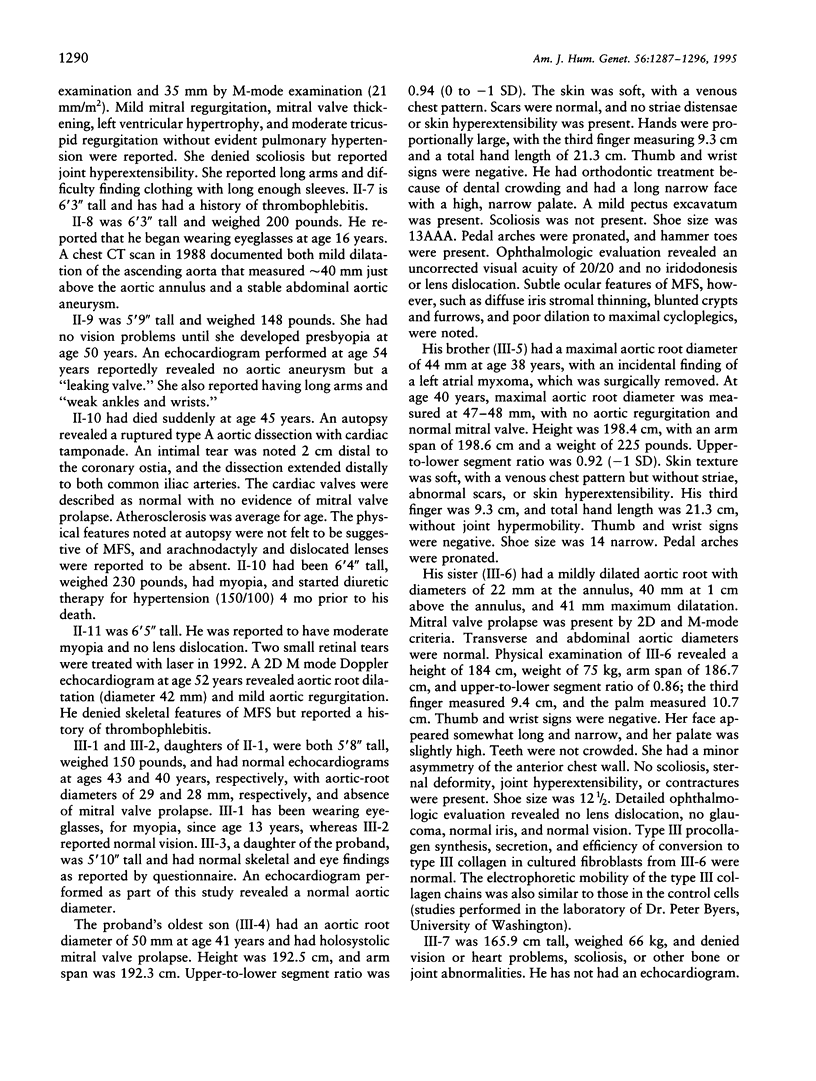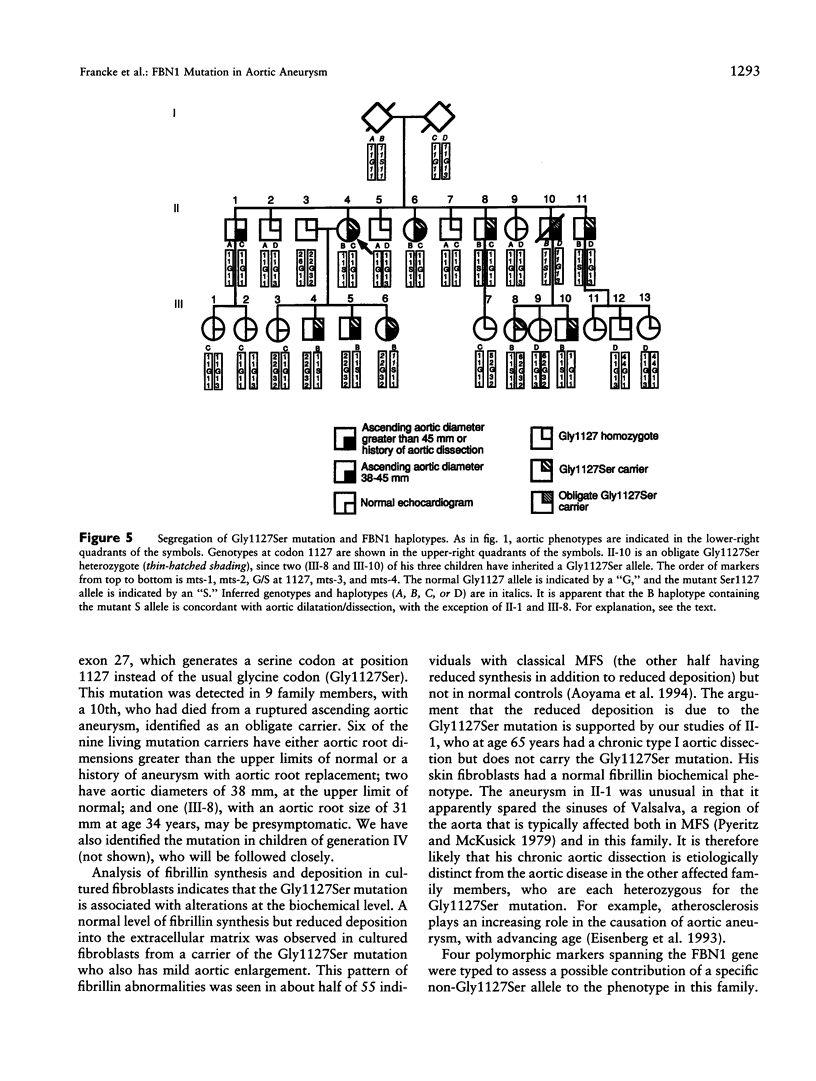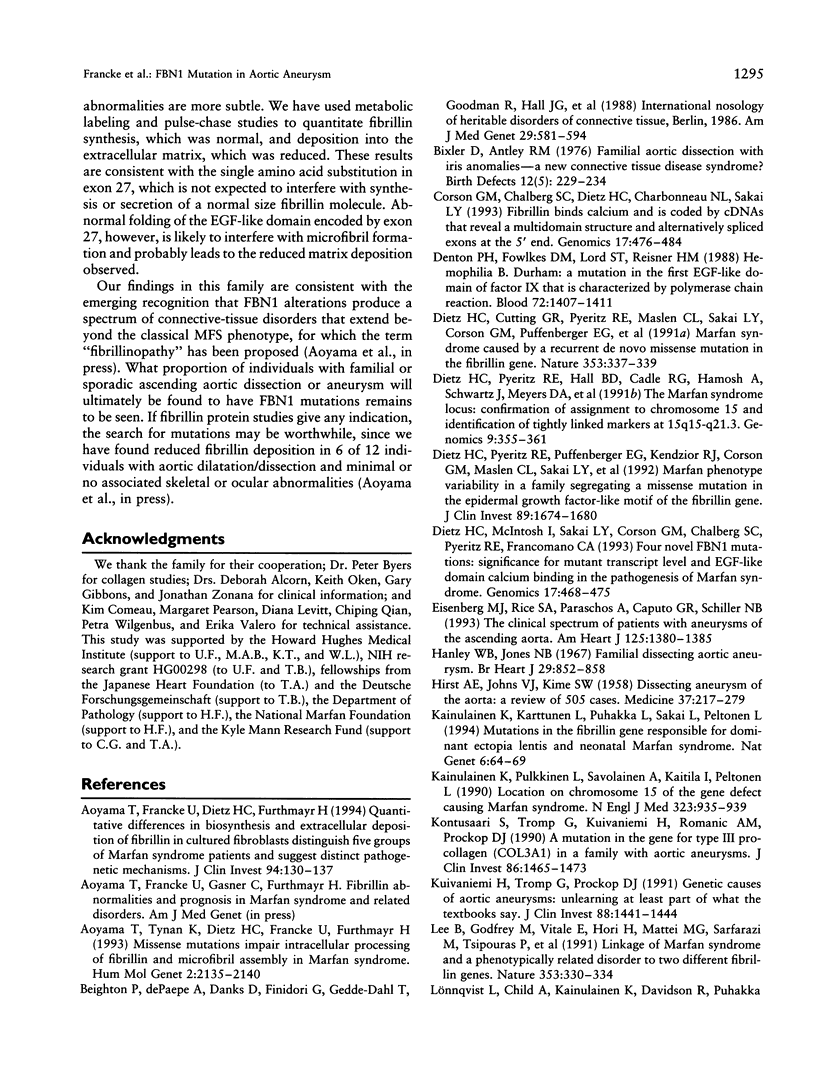Abstract
Ascending aortic disease, ranging from mild aortic root enlargement to aneurysm and/or dissection, has been identified in 10 individuals of a kindred, none of whom had classical Marfan syndrome (MFS). Single-strand conformation analysis of the entire fibrillin-1 (FBN1) cDNA of an affected family member revealed a G-to-A transition at nucleotide 3379, predicting a Gly1127Ser substitution. The glycine in this position is highly conserved in EGF-like domains of FBN1 and other proteins. This mutation was present in 9 of 10 affected family members and in 1 young unaffected member but was not found in other unaffected members, in 168 chromosomes from normal controls, and in 188 chromosomes from other individuals with MFS or related phenotypes. FBN1 intragenic marker haplotypes ruled out the possibility that the other allele played a significant role in modulating the phenotype in this family. Pulse-chase studies revealed normal fibrillin synthesis but reduced fibrillin deposition into the extracellular matrix in cultured fibroblasts from a Gly1127Ser carrier. We postulate that the Gly1127Ser FBN1 mutation is responsible for reduced matrix deposition. We suggest that mutations such as this one may disrupt EGF-like domain folding less drastically than do substitutions of cysteine or of other amino acids important for calcium-binding that cause classical MFS. The Gly1127Ser mutation, therefore, produces a mild form of autosomal dominantly inherited weakness of elastic tissue, which predisposes to ascending aortic aneurysm and dissection later in life.
Full text
PDF









Images in this article
Selected References
These references are in PubMed. This may not be the complete list of references from this article.
- Aoyama T., Francke U., Dietz H. C., Furthmayr H. Quantitative differences in biosynthesis and extracellular deposition of fibrillin in cultured fibroblasts distinguish five groups of Marfan syndrome patients and suggest distinct pathogenetic mechanisms. J Clin Invest. 1994 Jul;94(1):130–137. doi: 10.1172/JCI117298. [DOI] [PMC free article] [PubMed] [Google Scholar]
- Aoyama T., Tynan K., Dietz H. C., Francke U., Furthmayr H. Missense mutations impair intracellular processing of fibrillin and microfibril assembly in Marfan syndrome. Hum Mol Genet. 1993 Dec;2(12):2135–2140. doi: 10.1093/hmg/2.12.2135. [DOI] [PubMed] [Google Scholar]
- Beighton P., de Paepe A., Danks D., Finidori G., Gedde-Dahl T., Goodman R., Hall J. G., Hollister D. W., Horton W., McKusick V. A. International Nosology of Heritable Disorders of Connective Tissue, Berlin, 1986. Am J Med Genet. 1988 Mar;29(3):581–594. doi: 10.1002/ajmg.1320290316. [DOI] [PubMed] [Google Scholar]
- Bixler D., Antley R. M. Familial aortic dissection with iris anomalies--a new connective tissue disease syndrome? Birth Defects Orig Artic Ser. 1976;12(5):229–234. [PubMed] [Google Scholar]
- Corson G. M., Chalberg S. C., Dietz H. C., Charbonneau N. L., Sakai L. Y. Fibrillin binds calcium and is coded by cDNAs that reveal a multidomain structure and alternatively spliced exons at the 5' end. Genomics. 1993 Aug;17(2):476–484. doi: 10.1006/geno.1993.1350. [DOI] [PubMed] [Google Scholar]
- Denton P. H., Fowlkes D. M., Lord S. T., Reisner H. M. Hemophilia B Durham: a mutation in the first EGF-like domain of factor IX that is characterized by polymerase chain reaction. Blood. 1988 Oct;72(4):1407–1411. [PubMed] [Google Scholar]
- Dietz H. C., Cutting G. R., Pyeritz R. E., Maslen C. L., Sakai L. Y., Corson G. M., Puffenberger E. G., Hamosh A., Nanthakumar E. J., Curristin S. M. Marfan syndrome caused by a recurrent de novo missense mutation in the fibrillin gene. Nature. 1991 Jul 25;352(6333):337–339. doi: 10.1038/352337a0. [DOI] [PubMed] [Google Scholar]
- Dietz H. C., McIntosh I., Sakai L. Y., Corson G. M., Chalberg S. C., Pyeritz R. E., Francomano C. A. Four novel FBN1 mutations: significance for mutant transcript level and EGF-like domain calcium binding in the pathogenesis of Marfan syndrome. Genomics. 1993 Aug;17(2):468–475. doi: 10.1006/geno.1993.1349. [DOI] [PubMed] [Google Scholar]
- Dietz H. C., Pyeritz R. E., Hall B. D., Cadle R. G., Hamosh A., Schwartz J., Meyers D. A., Francomano C. A. The Marfan syndrome locus: confirmation of assignment to chromosome 15 and identification of tightly linked markers at 15q15-q21.3. Genomics. 1991 Feb;9(2):355–361. doi: 10.1016/0888-7543(91)90264-f. [DOI] [PubMed] [Google Scholar]
- Dietz H. C., Pyeritz R. E., Puffenberger E. G., Kendzior R. J., Jr, Corson G. M., Maslen C. L., Sakai L. Y., Francomano C. A., Cutting G. R. Marfan phenotype variability in a family segregating a missense mutation in the epidermal growth factor-like motif of the fibrillin gene. J Clin Invest. 1992 May;89(5):1674–1680. doi: 10.1172/JCI115766. [DOI] [PMC free article] [PubMed] [Google Scholar]
- Eisenberg M. J., Rice S. A., Paraschos A., Caputo G. R., Schiller N. B. The clinical spectrum of patients with aneurysms of the ascending aorta. Am Heart J. 1993 May;125(5 Pt 1):1380–1385. doi: 10.1016/0002-8703(93)91011-3. [DOI] [PubMed] [Google Scholar]
- HIRST A. E., Jr, JOHNS V. J., Jr, KIME S. W., Jr Dissecting aneurysm of the aorta: a review of 505 cases. Medicine (Baltimore) 1958 Sep;37(3):217–279. doi: 10.1097/00005792-195809000-00003. [DOI] [PubMed] [Google Scholar]
- Hanley W. B., Jones N. B. Familial dissecting aortic aneurysm. A report of three cases within two generations. Br Heart J. 1967 Nov;29(6):852–858. doi: 10.1136/hrt.29.6.852. [DOI] [PMC free article] [PubMed] [Google Scholar]
- Kainulainen K., Karttunen L., Puhakka L., Sakai L., Peltonen L. Mutations in the fibrillin gene responsible for dominant ectopia lentis and neonatal Marfan syndrome. Nat Genet. 1994 Jan;6(1):64–69. doi: 10.1038/ng0194-64. [DOI] [PubMed] [Google Scholar]
- Kainulainen K., Pulkkinen L., Savolainen A., Kaitila I., Peltonen L. Location on chromosome 15 of the gene defect causing Marfan syndrome. N Engl J Med. 1990 Oct 4;323(14):935–939. doi: 10.1056/NEJM199010043231402. [DOI] [PubMed] [Google Scholar]
- Kontusaari S., Tromp G., Kuivaniemi H., Romanic A. M., Prockop D. J. A mutation in the gene for type III procollagen (COL3A1) in a family with aortic aneurysms. J Clin Invest. 1990 Nov;86(5):1465–1473. doi: 10.1172/JCI114863. [DOI] [PMC free article] [PubMed] [Google Scholar]
- Kuivaniemi H., Tromp G., Prockop D. J. Genetic causes of aortic aneurysms. Unlearning at least part of what the textbooks say. J Clin Invest. 1991 Nov;88(5):1441–1444. doi: 10.1172/JCI115452. [DOI] [PMC free article] [PubMed] [Google Scholar]
- Lee B., Godfrey M., Vitale E., Hori H., Mattei M. G., Sarfarazi M., Tsipouras P., Ramirez F., Hollister D. W. Linkage of Marfan syndrome and a phenotypically related disorder to two different fibrillin genes. Nature. 1991 Jul 25;352(6333):330–334. doi: 10.1038/352330a0. [DOI] [PubMed] [Google Scholar]
- Lönnqvist L., Child A., Kainulainen K., Davidson R., Puhakka L., Peltonen L. A novel mutation of the fibrillin gene causing ectopia lentis. Genomics. 1994 Feb;19(3):573–576. doi: 10.1006/geno.1994.1110. [DOI] [PubMed] [Google Scholar]
- Magenis R. E., Maslen C. L., Smith L., Allen L., Sakai L. Y. Localization of the fibrillin (FBN) gene to chromosome 15, band q21.1. Genomics. 1991 Oct;11(2):346–351. doi: 10.1016/0888-7543(91)90142-2. [DOI] [PubMed] [Google Scholar]
- Majumder P. P., St Jean P. L., Ferrell R. E., Webster M. W., Steed D. L. On the inheritance of abdominal aortic aneurysm. Am J Hum Genet. 1991 Jan;48(1):164–170. [PMC free article] [PubMed] [Google Scholar]
- Maslen C. L., Corson G. M., Maddox B. K., Glanville R. W., Sakai L. Y. Partial sequence of a candidate gene for the Marfan syndrome. Nature. 1991 Jul 25;352(6333):334–337. doi: 10.1038/352334a0. [DOI] [PubMed] [Google Scholar]
- Narcisi P., Wu Y., Tromp G., Earley J. J., Richards A. J., Pope F. M., Kuivaniemi H. Single base mutation that substitutes glutamic acid for glycine 1021 in the COL3A1 gene and causes Ehlers-Danlos syndrome type IV. Am J Med Genet. 1993 May 15;46(3):278–283. doi: 10.1002/ajmg.1320460308. [DOI] [PubMed] [Google Scholar]
- Nicod P., Bloor C., Godfrey M., Hollister D., Pyeritz R. E., Dittrich H., Polikar R., Peterson K. L. Familial aortic dissecting aneurysm. J Am Coll Cardiol. 1989 Mar 15;13(4):811–819. doi: 10.1016/0735-1097(89)90221-0. [DOI] [PubMed] [Google Scholar]
- Pereira L., Levran O., Ramirez F., Lynch J. R., Sykes B., Pyeritz R. E., Dietz H. C. A molecular approach to the stratification of cardiovascular risk in families with Marfan's syndrome. N Engl J Med. 1994 Jul 21;331(3):148–153. doi: 10.1056/NEJM199407213310302. [DOI] [PubMed] [Google Scholar]
- Pyeritz R. E., McKusick V. A. The Marfan syndrome: diagnosis and management. N Engl J Med. 1979 Apr 5;300(14):772–777. doi: 10.1056/NEJM197904053001406. [DOI] [PubMed] [Google Scholar]
- Toyama M., Amano A., Kameda T. Familial aortic dissection: a report of rare family cluster. Br Heart J. 1989 Feb;61(2):204–207. doi: 10.1136/hrt.61.2.204. [DOI] [PMC free article] [PubMed] [Google Scholar]
- Tromp G., Wu Y., Prockop D. J., Madhatheri S. L., Kleinert C., Earley J. J., Zhuang J., Norrgård O., Darling R. C., Abbott W. M. Sequencing of cDNA from 50 unrelated patients reveals that mutations in the triple-helical domain of type III procollagen are an infrequent cause of aortic aneurysms. J Clin Invest. 1993 Jun;91(6):2539–2545. doi: 10.1172/JCI116490. [DOI] [PMC free article] [PubMed] [Google Scholar]
- Tsipouras P., Del Mastro R., Sarfarazi M., Lee B., Vitale E., Child A. H., Godfrey M., Devereux R. B., Hewett D., Steinmann B. Genetic linkage of the Marfan syndrome, ectopia lentis, and congenital contractural arachnodactyly to the fibrillin genes on chromosomes 15 and 5. The International Marfan Syndrome Collaborative Study. N Engl J Med. 1992 Apr 2;326(14):905–909. doi: 10.1056/NEJM199204023261401. [DOI] [PubMed] [Google Scholar]
- Tynan K., Comeau K., Pearson M., Wilgenbus P., Levitt D., Gasner C., Berg M. A., Miller D. C., Francke U. Mutation screening of complete fibrillin-1 coding sequence: report of five new mutations, including two in 8-cysteine domains. Hum Mol Genet. 1993 Nov;2(11):1813–1821. doi: 10.1093/hmg/2.11.1813. [DOI] [PubMed] [Google Scholar]
- Weber J. L., May P. E. Abundant class of human DNA polymorphisms which can be typed using the polymerase chain reaction. Am J Hum Genet. 1989 Mar;44(3):388–396. [PMC free article] [PubMed] [Google Scholar]





